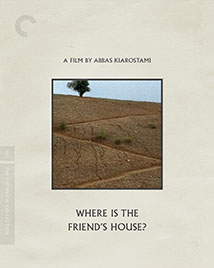
Each month, Paste brings you a look at the best new selections from the Criterion Collection. Much beloved by casual fans and cinephiles alike, Criterion has for over three decades presented special editions of important classic and contemporary films. You can explore the complete collection here. In the meantime, because chances are you may be looking for something to give the discerning (raises pinkie) cinephile this month, find all of our Criterion picks here, check out some of our top titles this June, and, hey, maybe sign up for Criterion’s Criterion Channel to stream many of the titles we talk about here.
Also out this month: New 4K digital restoration of Yasujiro Ozu’s The Flavor of Green Tea over Rice (1952), Douglas Sirk’s Magnificent Obsession (1954), featuring Rock Hudson’s first big role, and Lucille Cara’s travelogue, The Inland Sea (1991)
 An Angel at My Table
An Angel at My Table
Year: 1990
Director: Jane Campion
Janet Frame, New Zealand’s greatest author by seeming consensus, does not actually emerge into authorhood until nearly 2/3rds of the way through An Angel at My Table, New Zealand filmmaker Jane Campion’s portrait of Frame’s life and career (which happens to use Frame’s autobiographies as its foundation). For Frame, played by Karen Fergusson, Alexia Keogh and Kerry Fox over the course of childhood, adolescence,and adulthood, respectively, the wait is appropriate: It took about 30 or so years to secure her freedom from the mental institution where she was unjustly detained, as well as to secure her own agency, after all. Campion has no choice but to honor reality, ugly as Frame’s was for so much of her life. She grew up dirt poor in a literal sense, arriving at school visibly grimey; she witnessed horrible domestic abuse; she was shy, struggled with depression in an era where nobody, not even so-called professionals, had a damn clue what that meant. Frame’s is a tough background.
An Angel at My Table does not, however, wallow. In its fashion, it’s actually aspirational. Campion creates scenes of intimacy shared between Frame and her most beloved possessions, her books, gifts handed down to her by her custodians; eventually she seeks them out on her own, realizing that they’re her best route to ditch the bummer hand the universe has dealt her. The film divides her slow, lifelong emancipation from poverty and sadness into chapters, each chapter starring a new actress, orbiting new themes, adopting new styles to match Frame’s maturation on her journey to success and happiness largely unknown to her for much of her existence. There’s an alternating delicacy and firmness to Campion’s hand. In one moment, she acknowledges the unforgiving boundaries of Frame’s upbringing. In the next, she reveals gentler moments to her audience, relief from the strain of the seeming insurmountable difficulties Frame faced at every stage of her growth. And pulling off a film like An Angel at My Table isn’t an easy feat, risking either glorifying a subject’s unflattering circumstances or tipping right into hagiography. Campion wrote the blueprint for how to balance the light and the dark years ago. —Andy Crump
 Where is the Friend’s House?
Where is the Friend’s House?
Year: 1987
Director: Abbas Kiarostami
Though not technically his first feature (that’s The Traveler from 1974), Where is the Friend’s House? was the first to bring Abbas Kiarostami wider international recognition. It remains one of his finest works.
The story sounds almost ridiculously mundane, revolving around young Ahmed’s (Babek Ahmedpour) efforts to return classmate Nematzadeh’s (Ahmed Ahmedpour) notebook after he discovers he accidentally took it home with him. To such a simple story, though, Kiarostami brings a wealth of character observation, social criticism and, above all, the kind of humanistic wisdom that proved to be a hallmark of his cinema.
In its own documentary-like way, Where is the Friend’s House? offers a child’s-eye perspective on lower-class Iranian life, one in which most of the adults are either too busy to pay much attention to their children, or are too beholden to old-fashioned ways of discipline to offer them the love and affection they demand. Such is Kiarostami’s sense of humanity, however, that he’s even willing to indulge Ahmed’s grandfather (Rafia Difai) a lengthy defense of his harsh view of parenting, taking time to understand where he’s coming from despite how appalling his endorsement of regular beatings might sound to Western ears. And Ahmed eventually finds in an elderly door- and window-maker (Hamdollah Askarpour) he encounters in Nematzadeh’s town something of an unexpected kindred spirit: a rare generous soul who, despite his age, has enough innocence in him to question the recent modernizing trend of replacing his old doors with iron doors when those old doors seem perfectly functional.
Through such sly offhand moments, Where is the Friend’s House? suggests a broader perspective beyond the relatively trivial concerns of this one young boy. Ultimately, though, it’s empathy—chiefly, the kind that inspires Ahmed to risk the ire of his relatives just to return a notebook so its owner won’t be expelled from school—that suggests a way forward for Iranian society. It’s a worldview that Kiarostami himself would continue to practice, even as his art became more austere and experimental later on. —Kenji Fujishima
 And Life Goes On
And Life Goes On
Year: 1992
Director: Abbas Kiarostami
Between Where is the Friend’s House? and the second film in his retroactively realized Koker Trilogy, And Life Goes On, Kiarostami made Close-up and an earthquake devastated the region in which the first film was made, 50,000 dead in its wake. With a hunger for subtle meta-narratives and a seeming willingness to continue to scrutinize his work within the context of a greater social functionality, the Iranian director surveyed the tragedy of the natural disaster through a tender road movie, spending an afternoon with a director (Farhad Kheradmand) and his young son (Pouya Payvar) and his young son’s non-stop talking as they attempt to drive to Koker to determine if, following the earthquake in their region, the boys from Where is the Friend’s House? are still OK. We’re given no context, no idea why this director cares so much about the boys from the film, why he’s willing to wade aimlessly into the catastrophe, what he plans to do when or if he gets his answers—we only know that the director and his son are outsiders, from Tehran, used to a relative level of comfort and stability unknown to rural life. As the two slowly move through the wreckage—emergency vehicles and crews of all shapes and sizes digging, sorting, sifting and otherwise mourning through shell-shocked determination to find some order in all the chaos—Kiarostami and DP Homayoun Payvar capture long tracking shots of what lay just outside the director’s car, his son finally quiet, napping in the backseat. The director and his son, who is only truly concerned with the World Cup happening in Italy at the same time, meet local after local, inevitably coming across a few cast members in various small communities as they navigate closed or treacherous roads on the way to Koker, wherever it is.
The closer the director gets to Koker, the less his conception of the world he glimpses through Where is the Friend’s House? represents the reality of what he’s witnessing as these communities do what they can to keep living. He asks about their loss; they want to talk about what they haven’t lost. He asks about the dead; they respond with talk of the living, of the necessity of staying alive, of what it means to go on. He begins to understand the ineffable divide between his world and theirs—such an incomprehensible gap between classes, between ways of life, that it might as well be a difference between someone in a movie and someone watching that movie. Kiarostami attempts to find empathy, anything, in that divide, however deep. Only a few cameras, mounted to various fixed points on the car itself, imbibe most of the surrounding atmosphere; whether what the director experiences is staged or is improvised within the very real frame of a very real disaster’s aftermath, or some is melange of the two, matters less than the grace with which Kiarostami convinces the viewer of the inherent truth in what’s depicted: That in every tragedy there breeds an undeniable, inextinguishable hope. —Dom Sinacola
 Through the Olive Trees
Through the Olive Trees
Year: 1994
Director: Abbas Kiarostami
…And Life Goes On: Abbas Kiarostami wraps his previous film within a warm behind-the-scenes comedy, expanding the bounds of his meta-narrative even further, adding layers without sacrificing the simplicity of his messages—both those conveyed before and those to come. The “director” of “And Life Goes On” (Mohammad Ali Keshavarz) introduces Through the Olive Trees as a making-of document, and he begins by selecting a potential character from a pool of non-professional actresses: a group of schoolgirls. As was the case with the director in And Life Goes On (Farhad Kheradmand), the director of And Life Goes On is just a stand-in for Kiarostami, the actual director of those films, and in this, the third in his Koker Trilogy, he portrays himself directing Farhad Kheradmand, an actor played by Farhad Kheradmand—Kiarostami directing himself directing himself. Shadows of shadows of shadows. A character we meet in And Life Goes On (Hossein Rezai) takes much of the focus in Through the Olive Trees, as “Hossein”’s romantic travails with another actor eventually absorb the production crew. Against the ever-present clash of country life overtaken by city dwellers—and even within that are hierarchies of class, especially when Hossein’s paramour turns him down because he’s illiterate—brought into sharp relief by the ruin of the earthquake less the five years prior, Kiarostami warps reality in earnest, searching for authenticity in artifice. Far from exploiting “real” people to benefit contrivance, or drumming up drama to adhere to some sort of practical narrative arc, he reveals something essential: the powerful dignity of a place like Koker. —Dom Sinacola